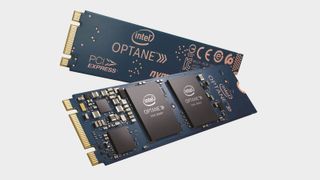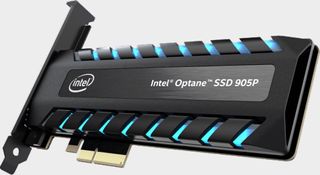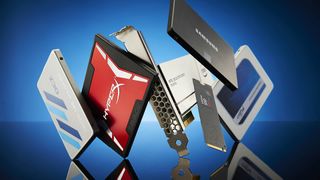Intel's Optane business is hurtling towards an unglorified end
Optane faces a bleak future after losses of hundreds of millions of dollars.

Intel’s Optane business suffered over half a billion dollars’ worth of losses over the course of 2020 according to figures drawn from Intel’s official 10K SEC filing. The figures come via Blocks and Losses (with thanks to Tom’s Hardware). Blocks and Losses goes on to speculate that the losses continue into 2021. If the predicted $529 million operating loss in 2021 is accurate, then the already shrinking Optane business is down well over a billion dollars over the last two years.
This is genuinely sad news. From a gaming perspective, many Optane drives were fast. Very fast. In fact, the Optane 900P was PC Gamer’s SSD of the year for 2017. The hallmark characteristics of 3D Xpoint memory was low latency, high in/out operations per second and excellent endurance ratings. These specs were far ahead of those of NAND SSDs from the same period. That made them desirable gaming SSDs, but promising technology is only successful if it's executed properly, and that’s where Intel failed.

Despite Optane’s appeal and strengths, at the consumer level Intel made some questionable product placement choices. It tried to position Optane drives as cache solutions for hard drives. Enthusiast users and and gamers had already shifted away from mechanical drives to SSDs, therefore cache drives didn't appeal to the group most likely to adopt new tech. At the other end of the spectrum, many budget systems still came with mechanical hard drives. However, budget systems with HDDs came with cheap motherboards. H310 for example didn't offer Optane support. That was a bit odd for sure.
Intel later produced hybrid Optane drives such as the H10 that combined NAND storage with an Optane cache, but again, pairing cheap QLC NAND with 32GB of pricey 3D XPoint memory left us wondering just who such a drive was aimed at. Was it a premium solution? The inclusion of QLC would say no, but at the same time it was too expensive compared to ever more affordable NAND SSDs. It's like Intel never quite worked out how to position Optane. It was either ultra high end or entry level, with little in between to truly appeal to the masses. The 800P was a perfect example. It was too expensive and too small.

Best SSD for gaming: the best solid state drives around
Best PCIe 4.0 SSD for gaming: the next gen has landed
The best NVMe SSD: this slivers of SSD goodness
Best external hard drives: expand your horizons
Best external SSDs: plug in upgrades for gaming laptops and consoles
The first signs that Optane was on shaky ground was when it sold off its share of a 3D XPoint manufacturing facility to its partner Micron. Intel has also since sold its entire NAND business to SK Hynix. Finally, the unsurprising news came in January 2021 when Intel announced that it was abandoning its consumer market plans.
Optane lives on in the datacentre. In that area, Intel continues to do well, notably with its Optane Persistent Memory products which blur the line between DRAM and storage. In short, it’s memory that retains its data when it's powered down. It’s particularly useful for things like database rebuilds, but imagine what it could have done for the desktop? Truly instant wake from sleep is one benefit that comes to mind.
The biggest gaming news, reviews and hardware deals
Keep up to date with the most important stories and the best deals, as picked by the PC Gamer team.
Sadly we’ll never get to see the best of Optane make it to the desktop. It promised so much, but it never lived up to the hype. Although it lives on in the data center, with financial losses like these, we fear it's only a matter of time before Optane products are retired for good. And that’s a real shame.

Chris' gaming experiences go back to the mid-nineties when he conned his parents into buying an 'educational PC' that was conveniently overpowered to play Doom and Tie Fighter. He developed a love of extreme overclocking that destroyed his savings despite the cheaper hardware on offer via his job at a PC store. To afford more LN2 he began moonlighting as a reviewer for VR-Zone before jumping the fence to work for MSI Australia. Since then, he's gone back to journalism, enthusiastically reviewing the latest and greatest components for PC & Tech Authority, PC Powerplay and currently Australian Personal Computer magazine and PC Gamer. Chris still puts far too many hours into Borderlands 3, always striving to become a more efficient killer.
Most Popular






